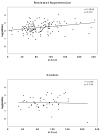Characterization of resistant hypertension: association between resistant hypertension, aldosterone, and persistent intravascular volume expansion
- PMID: 18541823
- PMCID: PMC2748247
- DOI: 10.1001/archinte.168.11.1159
Characterization of resistant hypertension: association between resistant hypertension, aldosterone, and persistent intravascular volume expansion
Abstract
Background: Resistant hypertension is a common clinical problem and greatly increases the risk of target organ damage.
Methods: We evaluated the characteristics of 279 consecutive patients with resistant hypertension (uncontrolled despite the use of 3 antihypertensive agents) and 53 control subjects (with normotension or hypertension controlled by using <or=2 antihypertensive medications). Participants were prospectively examined for plasma aldosterone concentration, plasma renin activity, aldosterone to renin ratio, brain-type natriuretic peptide, atrial natriuretic peptide, and 24-hour urinary aldosterone (UAldo), cortisol, sodium, and potassium values while adhering to a routine diet.
Results: Plasma aldosterone (P < .001), aldosterone to renin ratio (P < .001), 24-hour UAldo (P = .02), brain-type natriuretic peptide (P = .007), and atrial natriuretic peptide (P = .001) values were higher and plasma renin activity (P = .02) and serum potassium (P < .001) values were lower in patients with resistant hypertension vs controls. Of patients with resistant hypertension, men had significantly higher plasma aldosterone (P = .003), aldosterone to renin ratio (P = .02), 24-hour UAldo (P < .001), and urinary cortisol (P < .001) values than women. In univariate linear regression analysis, body mass index (P = .01), serum potassium (P < .001), urinary cortisol (P < .001), urinary sodium (P = .02), and urinary potassium (P < .001) values were correlated with 24-hour UAldo levels. Serum potassium (P = .001), urinary potassium (P < .001), and urinary sodium (P = .03) levels were predictors of 24-hour UAldo levels in multivariate modeling.
Conclusions: Aldosterone levels are higher and there is evidence of intravascular volume expansion (higher brain-type and atrial natriuretic peptide levels) in patients with resistant hypertension vs controls. These differences are most pronounced in men. A significant correlation between 24-hour urinary aldosterone levels and cortisol excretion suggests that a common stimulus, such as corticotropin, may underlie the aldosterone excess in patients with resistant hypertension.
Figures


References
-
- Gifford RW, Tarzi RC. Resistant hypertension: diagnosis and management. Ann Intern Med. 1978;88:661–5. - PubMed
-
- Chobanian AV, Bakris GL, Black HR, et al. Seventh report of the Joint National Committee on Prevention, Detection, Evaluation, and Treatment of High Blood Pressure. Hypertension. 2003;42:1206–52. - PubMed
-
- Hajjar I, Kotchen TA. Trends in prevalence, awareness, treatment, and control of hypertension in the United States, 1988-2000. JAMA. 2003;290:199–206. - PubMed
-
- Cushman WC, Ford CE, Cutler JA, et al. Success and predictors of blood pressure control in diverse North American settings: the antihypertensive and lipid-lowering treatment to prevent heart attack trial (ALLHAT) J Clin Hypertens (Greenwich) 2002;4:393–404. - PubMed
-
- Black HR, Eliott WJ, Grandits G, et al. Principal results of the Controlled Onset Verapamil Investigation of Cardiovascular End Points (CONVINCE) trial. JAMA. 2003;289:2073–82. - PubMed
Publication types
MeSH terms
Substances
Grants and funding
LinkOut - more resources
Full Text Sources
Other Literature Sources
Medical

